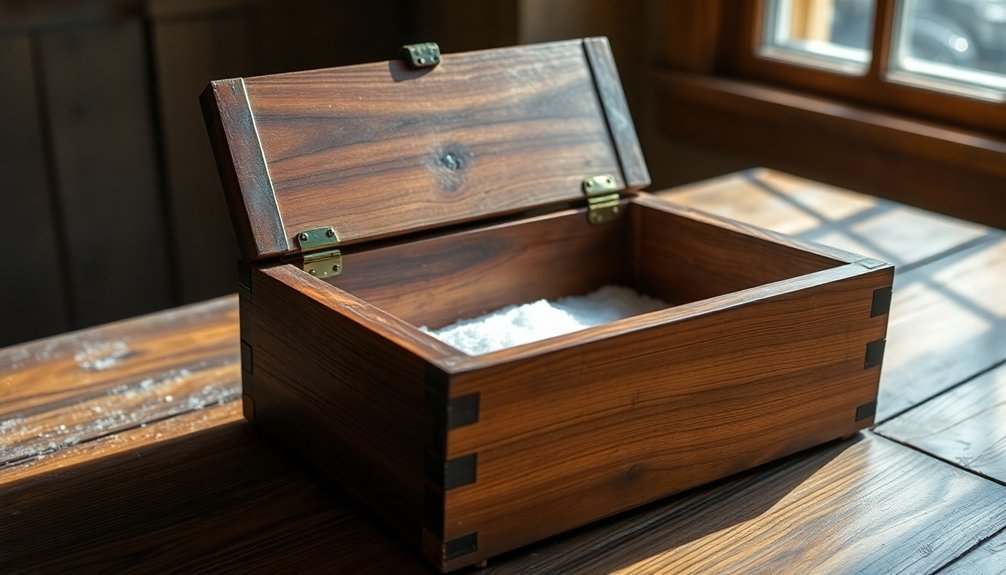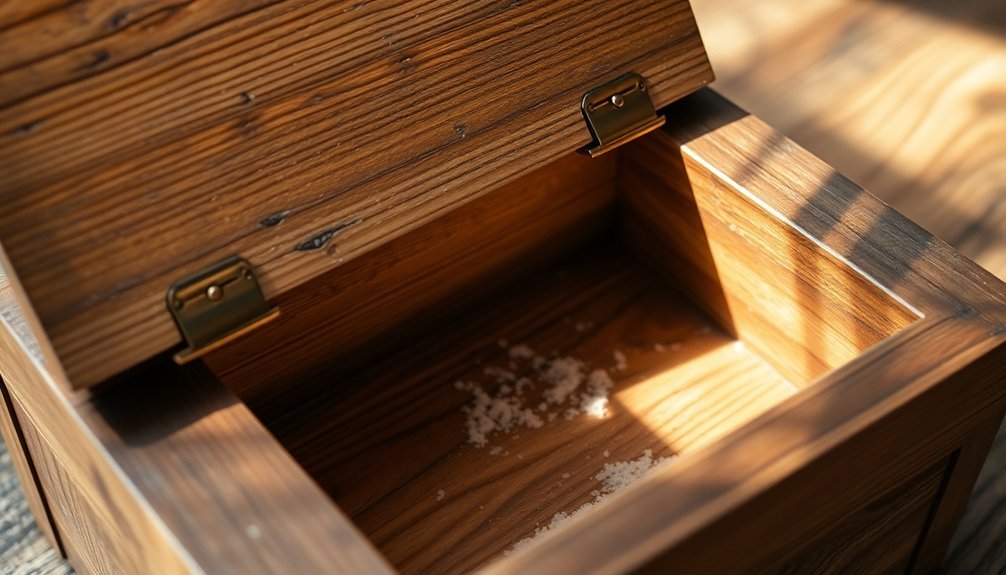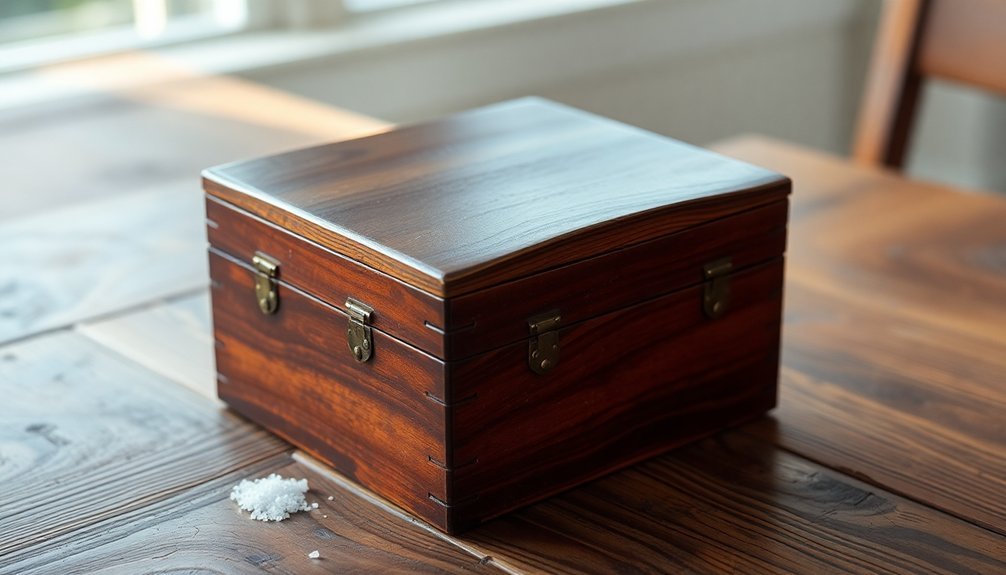Salt boxes can last for generations when you combine the right materials with proper construction and maintenance. High-density woods like olive wood and white oak provide natural durability, while their nonporous nature keeps salt fresh and prevents bacterial growth. You'll want single-block construction to guarantee seamless design and unique grain patterns. Salt itself acts as a natural preservative, drawing out moisture that could cause decay. Regular cleaning, moisture control, and proper storage away from water sources will protect your salt box from deterioration. Discover how ancient craftsmen's techniques continue to influence modern salt box longevity.
Ancient Salt Box Origins

The historical significance of salt boxes traces back to ancient Rome and Greece, where they served both practical and ceremonial purposes. You'll find evidence of these early vessels in Greek artifacts from the classical period, which resemble small bowls likely used for salt and other condiments. The Romans had their own version called the salinum, typically crafted from silver and used in both daily life and ceremonies.
When you examine ancient salt boxes, you'll discover they were crafted from an impressive range of materials. Early artisans worked with silver, glass, ceramic, metals, ivory, and wood to create these essential household items. The earthenware construction helped prevent salt from clumping in humid environments.
During the Middle Ages, you'd often see elaborate designs featuring sea motifs, reflecting both the origin of salt and the wealth of the owner.
You'll notice that salt boxes weren't just practical items – they carried significant social weight. If you were a guest at a medieval feast, your seating position relative to the master salt cellar would immediately reveal your social status. Being seated "above the salt" meant you were among the honored guests, while those "below the salt" held lower social standing.
Natural Wood Selection Methods
Selecting natural wood for salt boxes requires careful consideration of both durability and aesthetics. You'll want to focus on premium woods like olive wood, white oak, cherry, and Douglas fir, which offer the perfect balance of longevity and visual appeal.
Olive wood stands out as an exceptional choice due to its high density and nonporous nature, guaranteeing your salt stays fresh while preventing bacterial growth. The addition of a magnetic swivel lid ensures contents remain secure and protected during daily use.
When you're evaluating wood options, look for pieces cut from a single block, as they'll provide seamless construction and superior durability. The natural grain patterns make each salt box unique, and you'll find that Italian and Tunisian olive wood sources are particularly renowned for their quality.
You'll want to check that the wood has been properly dried and treated to prevent future warping or cracking.
Remember that the wood's breathability is vital – it helps keep your salt dry and free-flowing. While reclaimed timber can add character to your kitchen, make certain it's been properly treated and sealed.
The wood's density should be high enough to withstand daily use, yet not so dense that it becomes unwieldy for comfortable handling.
Traditional Construction Techniques

Building a traditional saltbox requires careful attention to structural principles that have endured for centuries.
You'll find that these homes start with equal-height side walls connected by floor and ceiling joists, creating a robust foundation for the structure. The rafters lock into compression at the roof's peak, while ceiling joists prevent walls from pushing outward.
To guarantee lasting stability, you'll need to incorporate corner braces that form triangles, adding essential rigidity to the walls.
When you're adding the signature sloped rear section, the original back wall becomes a vital load-bearing partition. The shed roof's design distributes weight evenly across both bearing walls, eliminating problematic outward thrust. Adding sturdy purlins can create impressive vertical spaces without compromising the roof's integrity.
If you're planning a more modern open-concept design, you'll need to compensate for any removed structural elements.
Consider using bents of progressive heights instead of traditional rafters – this technique maintains structural integrity while allowing for features like cathedral ceilings.
Don't forget that the central chimney, a hallmark of saltbox design, serves as both a functional element and a significant structural component that helps anchor the entire building.
Salt's Role In Wood Preservation
While traditional saltbox construction focuses on structural integrity, understanding salt's preservative properties helps explain these homes' remarkable longevity. Salt's natural desiccant properties draw moisture from wood, creating an environment where fungi and insects struggle to survive. This is particularly important in coastal areas where saltboxes often stand against harsh marine conditions.
You'll find that the preservation process involves specific sulfate salts, including ammonium, aluminum, and magnesium compounds. These salts don't just protect against biological decay – they also provide some fire resistance. Whether through pressure treatment, soaking, or surface application, these preservatives penetrate deep into the wood structure.
When you notice white crystalline deposits (efflorescence) on historical saltbox walls, you're actually seeing evidence of the preservation process at work. While this can cause some cosmetic issues like paint peeling, it's a sign that the wood contains active preservative compounds.
The key is maintaining the right balance – you want enough salt to protect the wood without causing excessive drying that could lead to brittleness. This delicate equilibrium has helped many saltboxes survive for generations.
Essential Maintenance Steps

In salt box maintenance, proper upkeep begins with systematic corrosion prevention. You'll need to guarantee the box stays completely dry after each use and regularly clean it with a pressure washer to remove residual salt. Don't forget to protect electrical connections with dielectric grease and replace worn components promptly.
Regular lubrication is essential for long-term preservation. You should grease the bearings on drive shafts every 10 hours of operation and lubricate input shaft bearings every 50 hours. Keep a close eye on mechanical components, including chains, conveyors, and rollers, replacing them when wear becomes evident.
| Maintenance Task | Frequency | Key Benefits |
|---|---|---|
| Pressure Washing | After each use | Prevents corrosion |
| Drive Shaft Lubrication | Every 10 hours | Extends part life |
| Input Shaft Greasing | Every 50 hours | Reduces wear |
| Electrical Inspection | Monthly | Guarantees reliability |
Store your salt box in a dry location when not in use, and conduct routine inspections to catch potential issues early. Following the manufacturer's maintenance schedule and using appropriate tools for repairs will greatly extend your salt box's lifespan and maintain its effectiveness through generations.
Environmental Storage Considerations
Proper storage location of salt boxes demands careful environmental consideration to protect water resources and ecosystems. You'll want to place your salt storage at least 300 feet away from potable water wells, public water systems, and surface waters. It's essential to avoid areas near streams, lakes, or ponds, and stay clear of primary water supplies and principal aquifers.
Your salt box needs complete protection from the elements to prevent environmental damage. Don't rely on tarps – install a permanent, impermeable roof that's secured against wind. You'll also need a concrete or asphalt floor that's impervious to prevent salt from seeping into the ground.
Be certain you've got proper drainage systems to keep precipitation from carrying salt into nearby water sources.
When you're choosing a location, consider the impact on local wildlife and vegetation. Salt that isn't properly stored can break down into sodium and chloride ions, altering soil chemistry and harming plants and aquatic organisms.
If you're in a Special Flood Hazard Area, verify your storage facility won't restrict the 100-year flood flow. Remember, proper storage isn't just about preservation – it's about protecting our water resources for future generations.
Common Threats To Longevity

Several threats can chip away at your salt box's longevity, making it vital to understand and address potential problems.
Material degradation stands as a primary concern, especially if you're using wooden salt boxes. Without proper maintenance and protection, wood can succumb to rot and decay from moisture exposure, while inadequate finishing leaves it vulnerable to damage.
Chemical reactions pose another significant threat. Salt's corrosive nature makes it incompatible with metal containers, and when combined with moisture, it can accelerate material breakdown. You'll need to be particularly careful about moisture control, as it often acts as a catalyst for various forms of deterioration.
Physical damage from daily use can't be ignored either. Regular handling, overfilling, and accidental drops can lead to cracks or structural weaknesses.
If you don't address maintenance needs promptly, such as loose parts or worn hinges, these issues can worsen over time. Your cleaning routine also plays a vital role – using inappropriate cleaning materials or failing to dry the box properly after cleaning can introduce moisture-related problems that compromise its integrity.
Restoration Of Vintage Pieces
Bringing vintage salt boxes back to life requires careful attention to historical accuracy and craftsmanship.
You'll want to start by salvaging original materials whenever possible, particularly oak and chestnut boards that maintain the structure's authenticity. Traditional timber frame construction methods should be preserved to guarantee structural integrity while respecting the historical significance of these pieces.
When restoring a vintage salt box, you'll need to focus on both exterior and interior elements. Hand-planed trim and wainscoting can match original craftsmanship, while careful management of plaster walls preserves historical accuracy.
Don't forget to incorporate modern safety features like proper insulation and weatherproofing without compromising the box's traditional charm.
- Original stone fireplaces must be preserved as key architectural features
- Early American furniture pieces can enhance the historical atmosphere
- Built-in features should blend seamlessly with the historical aesthetic
- Traditional framing techniques need to balance exterior design with interior functionality
Remember to maintain the original two-story front and one-story back design with its characteristic sloping roof.
If you're dealing with previous modernizations, you'll need to rebuild any removed walls to restore structural integrity and guarantee your salt box lasts for generations to come.
Frequently Asked Questions
Can Salt Boxes Be Used to Store Other Kitchen Items Safely?
You can store various seasonings, dried spices, and herbs in salt boxes since they'll protect against moisture. Just make certain your boxes are clean and dry before switching contents to maintain freshness.
How Do Different Wood Types Affect the Taste of Stored Salt?
You'll notice that neutral woods like olive and acacia won't affect your salt's taste, while pine or cedar can transfer unwanted flavors. That's why it's important to choose woods with minimal aromatic properties.
What Traditional Symbols or Markings Were Commonly Carved Into Salt Boxes?
You'll find salt boxes decorated with mythical creatures, geometric patterns, and folk art symbols. They often featured Fraktur designs, religious motifs, and traditional carvings that represented hospitality and good fortune in colonial homes.
Are Antique Salt Boxes Safe for Storing Modern Table Salt?
Yes, you can safely store modern table salt in antique salt boxes, but you'll need to guarantee they're well-sealed, free from damage, and kept in dry areas to prevent moisture absorption and protect both salt and box.
How Did Regional Designs of Salt Boxes Vary Across Different Cultures?
You'll find saltbox designs varied mainly between New England and Britain's colonial regions. In New England, they used wood construction with steep roofs, while other areas adapted the style using local materials like brick.
In Summary
You'll find that salt boxes truly can become family heirlooms when you follow time-tested practices. Choose dense hardwoods, employ tight-fitting joinery, and let the natural preservative effects of salt work in your favor. Keep your box away from extreme moisture and heat, perform regular maintenance, and you're looking at a piece that'll serve generations. Don't forget, even vintage boxes can be restored to their former glory.





Leave a Reply